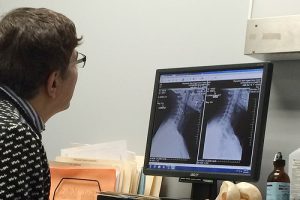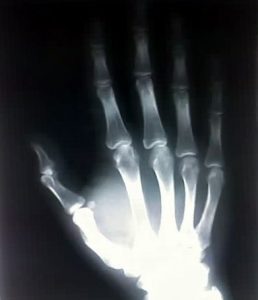Neck Pain Causes and Chiropractic Treatment
Houston Chiropractor Comments: What are some common neck pain causes? Neck pain is a very common complaint that chiropractic has been found to be very effective in treating.
Common Neck Pain Causes
There are many neck pain causes including posture related (such as a forward head carriage) and repetitive strain (such as long static holding of awkward positions). These two causes are very similar as the head weighs approximately 15 pounds and when held in a forward translated position for a lengthy time frame, the muscles fatigue and begin to ache. This is similar to holding a baby in your arms for a long time frame. We soon find ourselves moving the baby to the other arm or against our chest due to the gradual increasing strain placed our upper quarter muscles. Hence, we must similarly change the forward head position when we are working at the computer, listening or talking (especially if the person is not directly in front of you), reading a book, cooking, and so forth.
Another cause of neck pain is trauma. This could be neck pain from whiplash caused by a car accident, a slip-and-fall injury, sports injury, and more. These injuries are highly variable as no two injuries or accidents are the same and, there are a wide variety of neck sizes in both length and girth and hence, the same trauma may hardly result in an injury in one person and greatly injure a smaller, more petite person. Your doctor of chiropractic will ask you about the “mechanism of injury” as that can give us clues about which tissues are injured. For example, in a motor vehicle collision, if the impact occurs from the side verses the rear end of the car, the tissues in the neck are stretched differently and the management/treatment may vary accordingly.
Other neck pain causes include a “slipped” or herniated disk. A herniated disk is like a jelly donut where the jelly leaks out and presses against a nerve that travels down the arm. Symptoms often include pain, numb, tingling, burning, weakness, or combinations of these sensations down the course of the nerve. When this occurs, the person is usually quite specific about where the pain is traveling such as, “…it goes down my arm to my ring and little finger.” Dr. Beecher can offer chiropractic herniated disc neck treatment as well.

Another cause can be related to natural aging process involving the “wearing out” process of the disk, joints, and muscle/ligament attachments. The term, “osteoarthritis” is commonly associated with these findings and is often blamed for neck pain, but this is controversial. First, osteoarthritis (OA) takes years to develop and many people have a significant amount of OA but literally no pain or symptoms while others with only a little x-ray evidence of OA present with an abundance of pain.
Your Neck Pain Causes and Chiropractic Treatment
So, how do chiropractors manage all of these causes of neck pain? A thorough history, examination, and locating the positions of pain production verses pain relief are “key” to the successful management of patients with neck pain. For one patient, traction/stretching types of manual adjustment techniques work best while for the next, this may not be tolerated at all, which is why we “pre-position” the patient prior to administering an adjustment.
Other chiropractic treatment for neck pain considerations may include exercise instruction, physical therapy modalities (electric stim, ultrasound, etc.), the use of ice, re-adjustment of a computer monitor or work set up and nutritional considerations. If you, a family member or a friend require care, we sincerely appreciate the trust and confidence shown by choosing our service.
Dr. Ward Beecher practices at Beecher Chiropractic Clinic at 1001 Pineloch, Ste 700 Houston, TX 77062. You can schedule an appointment at BeecherChiropractic.com or by calling (281) 286-1300. If you have any questions regarding this blog, please comment below!
Natural Muscle Spasm Treatment
Clear Lake City Chiropractor Comments: A common question that I get consistently from patients, old or young, male or female, athletic or a couch potato is what they can do for muscle spasm treatment. For the sake of this article I will call a muscle spasm a forceful, intermittent & involuntary contraction of a muscle. A cramp is a sustained muscle spasm.
A muscle spasm is usually due to a muscle sprain, exercise, a joint irritation, dehydration, metabolic disorders or just overall fatigue. A cramp is due to the same things plus inadequate blood supply, mineral depletion or nerve compression.
Muscle Spasm Treatment
When you feel a muscle spasm or cramp, stop what you are doing. Try and massage and stretch the affected muscle out. If the problem is due to an acute (new) injury or sprain then put ice on it for 20 minutes and then off for 40 minutes. You can repeat this multiple times, but remember that after 20 minutes you will have gotten the maximum therapeutic benefit from the ice. The ice will help reduce the inflammation and irritation of the muscle. If this is a chronic (older) issue then moist heat will be beneficial. Use the heat for the same amount of time as the ice. Make sure that you are properly hydrated by drinking plenty of water. Coffee, tea and sodas are diuretics and tend to lead towards dehydration as does alcohol. If the spasm is due to exercise or an injury then make sure to give the muscles time to heal by minimizing activity. If things get worse, please consult with a physician or chiropractor about sports related rehabilitation or chiropractic rehabilitation.
Certain mineral deficiencies, such as calcium, potassium, magnesium and sodium can also lead to muscle cramps. The U.S. Department of Agriculture has recommendations for every vitamin and mineral in your diet. For potassium, the USDA suggests eating 4,700 milligrams per day. Potassium-rich foods include sweet potatoes, tomatoes, soy, yogurt and tuna. Your calcium intake should equal 1,000 milligrams per day. Good sources of calcium include sardines, soy, leafy green vegetables and dairy. A healthy diet also includes 420 milligrams of magnesium per day. Foods high in magnesium include nuts, squash, bran and lima beans. Other vitamins that can have an effect on your muscle irritability are vitamin D, E, B-1 & B-7. These all can help naturally treat muscle spasms.
Your Clear Lake Houston chiropractic Dr. Ward Beecher practices at Beecher Chiropractic Clinic at 1001 Pineloch, Ste 700 Houston, TX 77062. You can schedule an appointment at BeecherChiropractic.com or by calling (281) 286-1300. If you have any questions regarding this blog, please comment below!
Three Chiropractic Terms You Should Know
Three Chiropractic Terms You Should Know
Chiropractor In Clear Lake, TX Comments: Like all professions, chiropractic medicine has its own terminology. Every week I will have a new patient ask me what at least one of these three words mean. The three most common chiropractic terms that I am asked to define are chiropractic, subluxation and adjustment.
First Of The Three Chiropractic Terms Is Chiropractic.
This one always surprises me. Almost all of my patients are referred in by friends and family members that have already received excellent results over the past 26 years yet they don’t tell them what chiropractic is or what we do. Just to come to my office and we will get them better as quickly as possible. By definition chiropractic means done by hands. Chiropractic is a system of complementary medicine based on the diagnosis and manipulative treatment of misalignments of the joints, especially those of the spinal column, which are held to cause other disorders by affecting the nerves, muscles, and organs. In short, we use our hands (and sometimes instruments) to move joints (either in the spine or in the extremities) to help fix problems. At our office we also use physical modalities and exercises to help make sure that the problem does not return. Chiropractic is surprisingly one of the chiropractic terms you should know!
What Does Subluxation Mean?

What is the definition of subluxation? For most of our patients, this is one of the causes of their complaints. A subluxation is a partial dislocation or a bone that is slightly out of alignment with the bone next to it. This misalignment causes the joints to not line up correctly and the muscles to pull unevenly which causes pain, numbness, weakness etc.
Adjustment Is The Final Chiropractic Term
This is what is done to correct the subluxation. An adjustment uses a light, quick impulse of the hands (or an instrument) to move the joint back into the correct position. It is more specific than a general mobilization of a joint which a medical doctor, trainer or physical therapist will perform.
So in short if you are having neck, back or joint pain or discomfort the cause might be a subluxation that would be treated by an adjustment by a chiropractor. That is chiropractic.
Dr. Ward Beecher is your chiropractor in Clear Lake, TX and practices at Beecher Chiropractic Clinic at 1001 Pineloch, Ste 700 Houston, TX 77062. You can schedule an appointment at BeecherChiropractic.com or by calling (281) 286-1300. If you have any questions regarding this blog or any other chiropractic terms, please comment below, call, or email!
The Body & Mind and Connection of Whiplash?
Clear Lake Chiropractor
Clear Lake Chiropractor Comments: The term “whiplash” refers to an injury to the neck muscles, the muscle attachments (tendons), ligaments, and sometimes the disks that lie between the vertebral bodies of the spine. In a rear-end collision, the cause of whiplash occurs from a sudden, rapid acceleration of the body and neck as the car is pushed forwards. In these first moments following impact, the head remains in the same place while the body is propelled forward. This is followed by a “crack-the-whip” movement of the head and neck when the muscles in the front of the neck stretch like rubber bands and suddenly spring the head forwards, all occurring in less than 1 second. The force on the head and neck is further intensified if the seat back is too springy, or angled back too far. Also, if the headrest is too low, the head may ride over the top and more injury can result.
Treatment of whiplash

The treatment of whiplash varies from “watchful waiting” to a multidisciplinary team approach that includes neurology, physical therapy, chiropractic, psychology, and possibly surgery (rare). In an article published in the American Journal of Physical Medicine and Rehabilitation, the relationship between clinical, psychological and functional health status factors was investigated in a group of patients with chronic whiplash-associated disorder (WAD). A total of 86 patients with chronic WAD participated in the study and outcomes were tracked using questionnaires that measure pain, disability and psychological issues including depression, anxiety and catastrophizing. Physical examination factors included measuring the cervical range of motion. An analysis of the degree of neck disability and the relative contribution of physical vs. psychological factors revealed catastrophizing and depression played greater roles than did cervical range of motion. This suggests psychological factors play an important role in the outcome of whiplash.
Finding a Chirpractor
The importance of this is that more than just the physical factors like range of motion should be focused on when treating chronic whiplash patients. Answering the patient’s questions, explaining the mechanism of injury and how that relates to their specific condition, and addressing depression, anxiety, coping, and other psychological issues is very important. Discussing treatment goals with patients is also very important. For example, making light of the injury by stating something like, “…you’ll be fine after the treatments,” may harm the patient as anything short of “fine” may be interpreted as failed treatment by the patient. It is also important not to paint too dismal of a picture as that can have negative psychological effects as well, as this may suggest that they will never improve. Explaining the difference between “hurt” and “harm” is of great value to the chronic whiplash patient as they are often told, “if it hurts, don’t do it.” This sends an unfortunate message to the patient that any activity where an increase in pain occurs is “bad” when in fact, that activity may help the patient get better in the long run. This can make or break an acceptable outcome as many may feel like they shouldn’t do anything and this can lead to unemployment, boredom, and the many psychological issues previously described. The best advice is to remain active and try to ignore discomfort by staying within “reasonable activity boundaries.” Reasonable activity tolerance is learned as time passes and trying different activities for different lengths of time. This type of coaching should be at the center of chronic whiplash management rather than over focusing on physical factors such as range of motion. If you would like to know more about whiplash or would like treatment, please contact your Houston chiropractor, Beecher Chiropractic!
What Do Insurance Companies Say About Chiropractic?
Houston Chiropractic Comments: If chiropractic care helps patients get better faster and costs the patient and/or insurance company less, shouldn’t EVERY low back pain patient FIRST see a chiropractor before any other type of doctor? That is in fact, what should be done, based on the literature.

A few years ago a report was delivered on the impact on population, health and total health care spending. It was found the addition of chiropractic care for the treatment of neck and low back pain “…will likely increase value-for-dollar in US employer-sponsored health benefit plans.” Authored by an MD and an MD/PhD, and commissioned by the Foundation for Chiropractic Progress, the findings are clear; chiropractic care achieves higher satisfaction and superior outcomes for both neck and low back pain in a manner more cost effective than other commonly utilized approaches.
The study reviews the fact that low back and neck pain are extremely common conditions consuming large amounts of health care dollars. In 2002, 26% of surveyed US adults reported having back pain in the prior 3 months, 14% had neck pain and the lifetime prevalence of back pain was estimated at 85%. LBP accounts for 2% of all physician office visits where only routine examinations, hypertension, and diabetes result in more. Annual national spending is estimated at $85 billion in the US with an inflation-adjusted increase of 65% compared to 1997. The numbers have continued to rise thru 2016 as the population ages. Treatment options are diverse ranging from rest to surgery, including many various types of medications. Chiropractic care, including spinal manipulation and mobilization, is reportedly also widely utilized with almost half of all patients with persisting back pain seeking chiropractic treatment.
In review of the scientific literature, it is noted that 1) chiropractic care is at least as effective as other widely used therapies for low back pain; 2) Chiropractic care, when combined with other modalities such as exercise, appears to be more effective than other treatments for patients with neck pain. Other studies reviewed reported patients who had chiropractic coverage included in their insurance benefits found lower costs, reduced imaging studies, less hospitalizations, and surgical procedures compared to those with no chiropractic coverage. They then utilized a method to compare medical physician care, chiropractic physician care, physiotherapy led exercise and, manipulation plus physiotherapy-led exercise for low back pain care. They found adding chiropractic physician care is associated with better outcomes.
When combined with exercise, chiropractic physician care was also found to be very cost-effective when compared to exercise alone. When comparing the cost effectiveness of chiropractic care with or without exercise even at 5 times the cost of the care they utilized in their analysis, it was still found to be “substantially more cost-effective” compared to the other approaches. It will be interesting given these findings if insurance companies and future treatment guidelines start to MANDATE the use of chiropractic FIRST – it would be in everyone’s best interest!
If you, a family member or a friend require care, we sincerely appreciate the trust and confidence shown by choosing our services and look forward in serving you and your family presently and, in the future.
Dr. Ward Beecher practices at Beecher Chiropractic Clinic at 1001 Pineloch, Ste 700 Houston, TX 77062. You can schedule an appointment at BeecherChiropractic.com or by calling (281) 286-1300. If you have any questions regarding this blog, please comment below!

